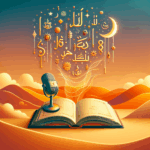How to Create a Multisensory Learning Experience for the Arabic Alphabet
Learning the Arabic alphabet can be a delightful journey if approached with creativity and a touch of fun. Engaging multiple senses not only makes the learning process more enjoyable but also more effective. Whether you’re a teacher, a parent, or a language enthusiast, this guide will help you craft a multisensory learning experience that brings the Arabic alphabet to life. 🌟
Table of Contents
1. Understanding Multisensory Learning
2. Visual Techniques
3. Auditory Strategies
4. Kinesthetic Approaches
5. Tactile Methods
6. Conclusion
7. FAQs
Understanding Multisensory Learning
Before diving into techniques, let’s clarify what multisensory learning means. It involves using multiple senses—sight, sound, touch, and movement—to enhance the learning experience. By engaging more than one sense, students can make stronger connections and improve memory retention. This approach is particularly beneficial for learning languages like Arabic, where the characters and sounds may be unfamiliar.
Visual Techniques
Visual stimuli are powerful tools for learning the Arabic alphabet. Here are some ideas:
1. Flashcards with Images: Pair each letter with a picture of an object whose name starts with that letter. This visual association helps in memorization.
2. Color-Coding: Use different colors for each letter or group of letters to help differentiate and categorize them. 🌈
3. Interactive Whiteboards: Utilize technology to draw and animate letters, making the learning process dynamic and engaging.
Auditory Strategies
Sound is a crucial element in language learning. Enhance auditory learning with these strategies:
1. Songs and Rhymes: Create catchy tunes or rhymes for each letter. Music aids memorization and makes learning enjoyable. 🎵
2. Pronunciation Guides: Record audio clips of the correct pronunciation and encourage students to listen and repeat.
3. Storytelling: Integrate letters into stories. Hearing them used in context helps learners understand their application.
Kinesthetic Approaches
Movement-based learning is effective for many students. Try these kinesthetic activities:
1. Letter Tracing: Use sand or salt trays for students to trace letters with their fingers. This tactile activity reinforces letter shapes. ✍️
2. Body Letters: Encourage students to form letters using their bodies. This fun activity also helps with letter recognition.
3. Alphabet Yoga: Combine kinesthetic learning with mindfulness by creating yoga poses for each letter.
Tactile Methods
Adding tactile experiences can make learning the Arabic alphabet more tangible:
1. Clay Modeling: Let students mold letters out of clay. This hands-on activity reinforces letter shapes and builds fine motor skills.
2. Textured Letters: Create letters using materials like sandpaper, felt, or fabric. Feeling different textures can help differentiate letters.
3. Sensory Bins: Fill bins with rice or beans and hide letters inside. Finding and identifying them adds an element of surprise and exploration.
Conclusion
Creating a multisensory learning experience for the Arabic alphabet is not only effective but also opens up a world of creativity and exploration. By engaging the senses, learners can form deeper connections with the material, making the process both memorable and enjoyable. You’re not just teaching letters; you’re crafting an enriching educational journey. 🚀
FAQs
Q: How long does it typically take to learn the Arabic alphabet using multisensory techniques?
A: The time varies depending on the learner’s age, dedication, and exposure. However, multisensory learning can accelerate the process by making it more engaging.
Q: Are these techniques suitable for all age groups?
A: Absolutely! These techniques can be adapted for any age group, from young children to adults, by tailoring the activities to suit the learners‘ interests and abilities.
Q: Can I use these methods for other languages?
A: Yes, multisensory learning techniques are versatile and can be applied to any language, especially those with unique scripts or sounds.






